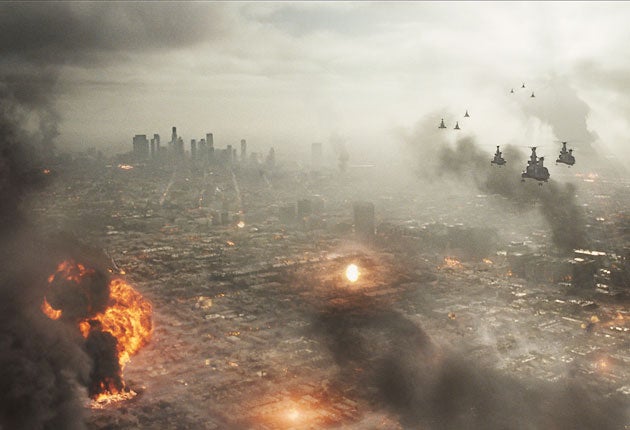Disaster movies are pulled from Japanese screens after tsunami

A woman in a luxury hotel at an Asian beach resort goes for a wander - it's an idyllic and beautiful setting but there is something ominous in the air. Suddenly, before she or the street vendors can get away to safety, a huge tsunami comes rolling towards them, sweeping up everything in its path.
Thus begins Clint Eastwood's recent film Hereafter. It is a spectacular and grim overture which inevitably has become very uncomfortable to watch for some audiences in the wake of last month's disasters.
Following the earthquake and tsunami in Japan, Hollywood studios have postponed the releases of several films featuring images of mass destruction, flooding or entrapment.
Hereafter (which had already been released) was quickly pulled from Japanese cinemas with Warner Bros conceding that certain scenes "were not appropriate".
Another movie held back was Sony's Battle: Los Angeles. In The New Yorker's words, this is "a quiet, uneventful chamber piece... in which almost nothing happens except that a humongous army of homicidal aliens splashes down off the coast of California, marches ashore, annihilates every human in sight, and sets about sucking up water from the face of the earth".
Japanese audiences will also have to wait to see Universal's Australian-made 3D adventure drama Sanctum, with James Cameron as executive producer, in which an underwater cave diving team end up stranded after a freak tropical storm.
It's easy to see why such films have been delayed or taken out of theatres.
Showing them now would be tasteless, insensitive - and a very bad idea from the point of view of potential box-office.
The film industry's focus has been more on revenue than on the sufferings of the Japanese people, as encapsulated in the reporting of trade paper The Hollywood Reporter last month in the immediate aftermath of the tsunami: "The good news is that theatrical exhibition continued in more or less reasonable fashion in those parts of Japan not affected by the earthquake."
One irony about the decision to shelve these films is that Japanese audiences have always savoured disaster movies.

Watch Apple TV+ free for 7 days
New subscribers only. £8.99/mo. after free trial. Plan auto-renews until cancelled

Watch Apple TV+ free for 7 days
New subscribers only. £8.99/mo. after free trial. Plan auto-renews until cancelled
Whether it's manga adaptations such as Akira(which starts with Tokyo being destroyed by a nuclear explosion), or Godzilla monster movies, or bloodcurdling yakuza movies, an apocalyptic undertow can be felt in almost every Japanese genre.
There is something paradoxical about Hollywood's attitude toward disaster movies. Such films are made because of audiences' desire to stare into the abyss. There's clearly a demand for them. Even so, the studios remain sensitive about offending audiences.
The disaster movie has moved relentlessly upmarket over the past 50 or 60 years, leaving the B-movie behind.
"I destroyed Washington, I destroyed the Golden Gate Bridge, I destroyed New York," special effects maestro Ray Harryhausen used to boast of the monsters he unleashed in B-movies like The Beast From 20,000 Fathoms and It Came From Beneath the Sea.
Now, disaster movies seem very realistic - which makes them all the harder to dismiss as fantasy.
Subscribe to Independent Premium to bookmark this article
Want to bookmark your favourite articles and stories to read or reference later? Start your Independent Premium subscription today.

Join our commenting forum
Join thought-provoking conversations, follow other Independent readers and see their replies